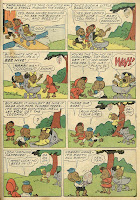I'm back after a long spell of no time to post. I've been recovering from a horrid case of sinusitis, aggravated by my growing chemical sensitivity... I had to abandon my apartment for a week while they tore up the dusty, filthy old carpet in the hallways, sprayed pesticide all over the place, then laid in new, formaldehyde-fragrant carpeting. Pretty soon I'll be starring in the made-for-cable movie,
The Middle-Aged Guy in the Plastic Bubble.
To conclude a "Tom & Jerry" trilogy, here are two stories from
Our Gang Comics #48. The first story is a Stanley rarity: a not-so-hot effort.
The
Mortal Kombat format of the "Tom & Jerry" animated cartoons is loutish, at best. Despite their lovely, flowing animation, the Hanna-Barbera MGM cartoons perennially cater to the lowest common denominator.
(
AFTERTHOUGHT: I do like several of the 1940s Tom and Jerry cartoons, especially
Mouse Trouble and
Mouse in Manhattan. In my estimation, there are probably a dozen truly great Tom & Jerry theatrical cartoons from the Hanna-Barbera unit. I stand by my general opinion of the series. There are too many pedestrian, mechanical and needlessly brutal T&Js for my taste as a cartoonophile.)
In his first round as writer of the T&J comic book series for
Our Gang, John Stanley took advantage of the free rein Western's creators were given with licensed materials.
He catered to the chase-and-clobber format of the cartoons, but Tom Cat was always a supporting character. Stanley's sympathies, as usual, went to the two mice, Jerry and diaper-clad Tuffy. They were perfect Stanley fodder: two outsiders, making their way through an uncertain, unexplained world.
Their reactions to the everyday experiences of human life make for marvelous comedy. As well, Stanley could not help but infuse the crude routine of the cartoon version with some genuine wit.
As we saw in my last post, Stanley's identification with the mice still produced first-rate stories upon his return to the
Our Gang book in 1947/8. When required to include Tom, Stanley entered awkward territory.
Not to say the following story is necessarily bad. It isn't a willful act of self-sabotage, a la Carl Barks' "Somethin' Fishy Here," a backup story required for the second issue of
Uncle Scrooge when one of his masterworks, "Back To The Klondike," was castrated by Western's Los Angeles editors.
"Somethin' Fishy Here" seethes with indignation, and is a surprisingly sharp screw-you to the indifference of Barks' editors. Barks was picked on as a creator much more than Stanley. Of course, he worked with a much hotter property--a Disney entity--and stricter rules applied, perhaps unfairly. Barks delivered an appealing, compelling Donald Duck. The Disney animated cartoons did not.
That said, Western's East Coast offices appear to have exercised a much looser editorial hand than the LA branch. The comics from this office are much more homogenized and bland than the New York material.
Thank goodness Stanley was on the East Coast. He regularly indulged in morbid, dark themes in his 1940s and '50s work, and was only apparently censored once, for the 1950
Little Lulu story "The Bogeyman."
This untitled story requires Stanley to buy into the standard "Tom & Jerry" format. He is clearly uncomfortable with the series' demands. There is a bit of that "Somethin' Fishy Here" vibe to this story. He still sides with the mice. They're placed in a high-stakes narrative--the dark flip-side to the frequent boys vs. girls stories in Stanley's
Little Lulu classics.
The story, to me, falls flat--this is Stanley on a rare off-day. As such, it is fascinating to study. All the elements are there. What is missing is Stanley's personal involvement in the piece. Without that quality, it's merely a better-than-average, very ordinary comic-book story.










Made it through that? Here's your reward!
A sub-feature of
Our Gang, as it morphed into
Tom and Jerry Comics, was "The Adventures of Tom." This mouse-free feature showed us Tom's frustrations in the dating scene.
In this surprisingly strong story, Stanley casts Tom as a proto-Tubby-- a disgruntled misfit. Like Tubby, Tom, in this story, is utterly convinced of the rightness of his worldview, and of his actions.
Notable is Tom's failed attempts to master musical instruments--including, most recognizably for
LL fans, the violin.
The SKREEEKs and SKRAAAKs Tom produces on the instrument--harsh tones that threaten the dental (and mental) health of anyone who hears them--aniticipate Tubby Tompkins' similar lack of violin mastery, in many a 1950s
Lulu story.
As well, the story's supporting characters seem like extras who wandered over from
New Funnies. This visual overlap confirms Stanley's obvious hand in this story.
In the first story here, Stanley seems burdened by the cat characters. In the second story, Stanley makes a virtue out of Tom, who was doomed to be a one-dimensional, homicidal villain in most of his media appearances.
These two stories provide us an unusually vulnerable side of Stanley the comix creator. There are surprisingly few outright flops amongst the thoustands of comic book stories Stanley wrote and drew. And tho', as said, the first story here isn't bad, it's clear that Stanley needed to connect with his characters--for their flaws more often than their virtues--to do his best work.







































